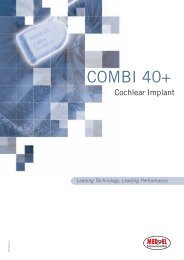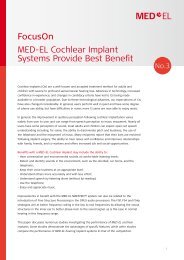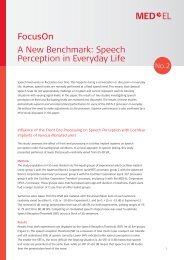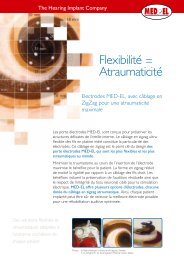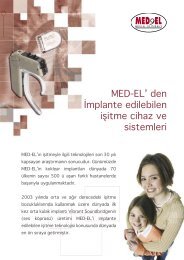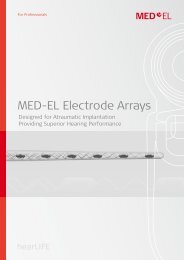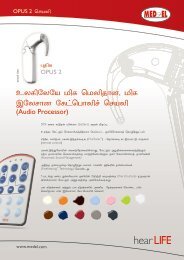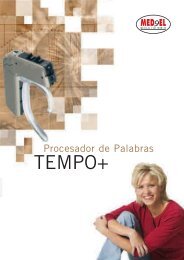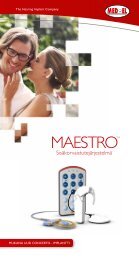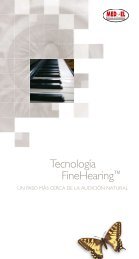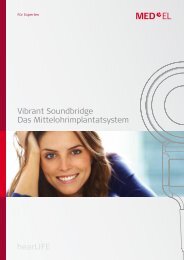Create successful ePaper yourself
Turn your PDF publications into a flip-book with our unique Google optimized e-Paper software.
GLOSSARY OF TERMS<br />
LED indicator :: The small red light on the front of the processor will flash in a<br />
variety of blinking patterns to indicate different status or error conditions of the<br />
processor or batteries.<br />
Localize :: The act of locating the source of a sound.<br />
Magnet :: There are two magnets in the system: one in the coil and the other in the<br />
implant case. Together the two hold the coil in place on the head. The implant center<br />
audiologist can adjust the magnetic strength of the coil.<br />
Map :: The program stored in the speech processor that tells the system how<br />
to process sound on each channel so that it is most audible and comfortable for<br />
the individual user. Each implant user’s map varies considerably from every other<br />
user. Maps also change over time, as the human body also fluctuates slightly in its<br />
sensitivity to electrical stimulation over time.<br />
Mapping sessions :: A visit to the implant center where the individual’s speech<br />
processor program is evaluated and changed if necessary<br />
Mastoid bone :: The area of bone directly behind the ear where the implanted<br />
portion of the system is placed.<br />
Microphone port :: The tiny opening on the front corner of the processor is the<br />
microphone port.<br />
Microphone test device (MTD) :: An optional accessory that allows a hearing<br />
person to listen to the microphone of the processor to determine whether it is<br />
functioning adequately.<br />
Middle ear :: The anatomical portion of the ear just beyond the eardrum. The<br />
middle ear consists of a small air space that holds the three small bones of hearing<br />
(malleus, incus and stapes). The Eustachian tube allows air exchange between the<br />
middle ear air space and the outside; when the ears ‘pop’ during a change in altitude,<br />
this is actually the pressure equalizing between the middle ear and the outside. The<br />
middle ear is the most common site of an ear infection.<br />
Mixing cables :: “Mixing” refers to a feature of certain assistive listening devices (such<br />
as FM systems) that allows the user to combine the signal from the speaker with the<br />
signal from the speech processor microphone. The processors support this feature,<br />
but it is necessary to ensure that a mixing patch cable is in use.<br />
Most comfortable loudness (MCL) :: MCL refers to a loudness level that is loud,<br />
but still comfortable, to the listener. This is an important measurement made on<br />
each channel during a mapping session. The final MCL setting of the map sets an<br />
upper limit for loudness, and stimulation will never exceed that limit. MCL levels are<br />
different for each user; therefore it is important that speech processors are never<br />
traded between users.<br />
MRI scan :: Magnetic Resonance Imaging is a medical diagnostic procedure.<br />
At the time of printing, MEd-EL cochlear implants are FdA approved for 0.2T (Tesla)<br />
MRI scanners without the removal of the implant’s internal magnet. Only machines<br />
of 0.2T strength should be utilized with MEd-EL at this time. Additional factors,<br />
such as head placement, make it important for the scanning radiologist to contact<br />
MEd-EL prior to scheduling the MRI scan.<br />
Newborn hearing screening :: A program in place in many hospitals that allows a<br />
child’s hearing to be evaluated immediately after the baby is born.<br />
ON/OFF switch :: The ON/OFF switch is located on each of the TEMPO+ and<br />
OPUS 1 battery packs. The battery pack lock functions as the ON/OFF switch for<br />
the OPUS 2.<br />
Otologist/Neurotologist :: An otologist is a physician who first became an ear,<br />
nose and throat specialist, and then went on to specialize in just the ears and<br />
the area of the head surrounding the ear. An otologist completes over 10 years<br />
of medical training and a specialized otology training fellowship prior to entering<br />
practice.<br />
Outer ear :: The anatomical portion of the hearing system that includes the pinna<br />
(the visible “ear” on the outside of the head), the ear canal, and the eardrum<br />
(tympanic membrane).<br />
Phoneme :: The smallest unit in a language that is capable of conveying a change in<br />
meaning. For example, the m in mat and the b in bat. There are 41 phonemes in the<br />
English language<br />
Phonemic repertoire :: The range of various phonemes (speech sounds) that a<br />
child is able to produce. Generally, certain speech sounds seem to develop earlier<br />
than others over a period of several years.<br />
Play audiometry :: An audiometric technique that teaches a young child to complete<br />
an activity when a sound is heard (such as dropping a block into a container or<br />
putting a piece in a puzzle). This facilitates testing the hearing of preschoolers and<br />
toddlers.<br />
48 EQUIPMENT GUIdE: TEMPO+ and OPUS 1 SPEECH PROCESSORS<br />
49



